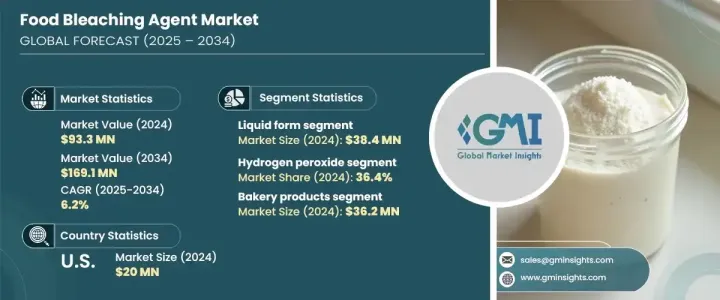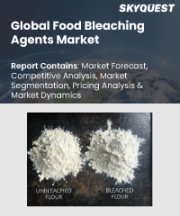
|
시장보고서
상품코드
1684592
세계의 식품용 표백제 시장 : 기회, 성장 촉진요인, 산업 동향 분석, 예측(2025-2034년)Food Bleaching Agent Market Opportunity, Growth Drivers, Industry Trend Analysis, and Forecast 2025 - 2034 |
||||||
세계의 식품용 표백제 시장은 2024년 9,330만 달러로 평가되었고, 2025년부터 2034년까지 CAGR 6.2%를 나타낼 것으로 예측됩니다.
화학적 형태와 천연 형태 양쪽에서 사용할 수 있는 이러한 약물은 색상의 명색화 또는 제거를 통해 식품의 시각적 매력을 높임으로써 식품 가공 산업에서 중요한 역할을 합니다. 가공 식품의 품질과 외관을 향상시키는 능력은 외형이 소비자에게 어필의 열쇠가 되는 경쟁이 치열한 식품 업계에서 필수적입니다.

편리하고 빨리 먹을 수 있는 식품에 대한 소비자의 선호 증가가 식품용 표백제 수요를 뒷받침하고 있습니다. 가공식품과 포장식품이 가정의 주식이 됨에 따라 제조업체는 점점 더 이러한 제품이 구매자를 끌어들이도록 시각적으로 매력적으로 보이게 하는 데 중점을 두고 있습니다. 식품 표백제는 밀가루, 설탕, 기름 및 기타 가공품과 같은 제품에 균일성과 밝기를 효과적으로 부여하여 시장 잠재력을 높입니다. 보다 깨끗한 라벨과 천연 성분으로의 전환은 이 시장의 기술 혁신을 더욱 촉진하고 기업은 진화하는 소비자의 기대에 부응할 수 있습니다.
| 시장 범위 | |
|---|---|
| 시작 연도 | 2024년 |
| 예측 연도 | 2025-2034년 |
| 시작 금액 | 9,330만 달러 |
| 예측 금액 | 1억 6,910만 달러 |
| CAGR | 6.2% |
형태별로는 액체와 분말 형태가 있습니다. 액체 표백제는 2024년에 3,840만 달러로 평가되었고, 도포가 용이하고 식품 가공 중에 안정된 결과를 얻을 수 있기 때문에 제조업체에게 선호되고 있습니다. 범용성은 음료, 유제품 및 기타 액체 기반 식품과 다양한 용도로 최선의 선택입니다. 이러한 약물은 생산 공정에 원활하게 통합하면서 효율적인 표백을 가능하게 하고 경쟁 시장에서 우위를 발휘합니다.
유형별로는 과산화수소가 2024년 주요 식품용 표백제로 부상하여 36.4%의 점유율을 획득했습니다. 과산화수소는 표백제와 산화제로서의 이중 기능으로 널리 인정되어 가공 식품의 품질과 외관을 현저하게 향상시킵니다. 과산화수소의 용도는 베이커리, 유제품, 음료의 각 분야 및 제품을 밝게 할 뿐만 아니라 미생물의 번식을 억제하여 보존 기간을 연장하는데 도움이 됩니다. 과산화수소의 적응성과 효능은 식품 가공 산업의 핵심으로 자리매김하고 있습니다.
미국에서는 베이커리 제품, 과자류, 유제품 등의 가공 식품의 왕성한 수요에 견인되어, 식품용 표백제 시장은 2024년 2,000만 달러에 달했습니다. 이 나라의 견조한 식품 가공 부문과 외형에 아름다운 제품에 대한 소비자의 선호가 표백제의 성황 시장을 창출하고 있습니다. 게다가 클린 라벨 제품에 대한 관심이 높아져 식품 제조 투명성을 우선하는 건강 지향 소비자를 위한 천연 표백 솔루션의 채용을 제조업체에 촉구하고 있습니다.
목차
제1장 조사 방법과 조사 범위
- 시장 범위와 정의
- 기본 추정과 계산
- 예측 계산
- 데이터 소스
- 1차
- 2차
- 유료소스
- 공적소스
제2장 주요 요약
제3장 업계 인사이트
- 생태계 분석
- 밸류체인에 영향을 주는 요인
- 이익률 분석
- 변혁
- 미래의 전망
- 제조업체
- 유통업체
- 공급자의 상황
- 이익률 분석
- 주요 뉴스
- 규제 상황
- 영향요인
- 성장 촉진요인
- 시각적 강화가 필요한 가공 및 포장 식품 수요 증가
- 베이커리 및 과자류에 표백제 채용 증가
- 천연 및 합성 식품용 표백제의 기술적 진보
- 업계의 잠재적 리스크 및 과제
- 소비자의 클린 라벨 지향과 천연 소재 지향 확대
- 시장 성장에 영향을 미치는 합성 표백제에 관한 잠재적인 건강 우려
- 성장 촉진요인
- 성장 가능성 분석
- Porter's Five Forces 분석
- PESTEL 분석
제4장 경쟁 구도
- 소개
- 기업의 시장 점유율 분석
- 경쟁 포지셔닝 매트릭스
- 전략 전망 매트릭스
제5장 시장 규모와 예측 : 형태별, 2021-2034년
- 주요 동향
- 액체
- 분말
제6장 시장 규모와 예측 : 유형별, 2021-2034년
- 주요 동향
- 아조디카르본아미드
- 과산화수소
- 아스코르브산
- 과산화아세톤
- 이산화염소
- 기타
제7장 시장 규모와 예측 : 용도별, 2021-2034년
- 주요 동향
- 베이커리 제품
- 밀가루
- 치즈
- 기타
제8장 시장 규모와 예측 : 지역별, 2021-2034년
- 주요 동향
- 북미
- 미국
- 캐나다
- 유럽
- 영국
- 독일
- 프랑스
- 이탈리아
- 스페인
- 러시아
- 아시아태평양
- 중국
- 인도
- 일본
- 한국
- 호주
- 라틴아메리카
- 브라질
- 멕시코
- 중동 및 아프리카
- 남아프리카
- 사우디아라비아
- 아랍에미리트(UAE)
제9장 기업 프로파일
- American Elements
- Arkema
- DSM
- Evonik Industries
- Gujarat Alkalies and Chemicals
- Ineos
- Kemira
- Loba Chemie
- Nouryon
- Solvay
- United Initiators
The Global Food Bleaching Agent Market, with a valuation of USD 93.3 million in 2024, is projected to grow at a CAGR of 6.2% from 2025 to 2034. These agents, available in both chemical and natural forms, play a vital role in the food processing industry by enhancing the visual appeal of food products through color lightening or removal. Their ability to improve the quality and appearance of processed foods has made them indispensable in the competitive food industry, where presentation is key to consumer appeal.

A growing consumer preference for convenient, ready-to-eat food options is fueling the demand for food bleaching agents. As processed and packaged foods become household staples, manufacturers are increasingly focusing on ensuring these products look visually appealing to attract buyers. Food bleaching agents effectively deliver uniformity and brightness to products like flour, sugar, oils, and other processed goods, enhancing their market potential. The shift toward cleaner labels and natural ingredients has further driven innovation in this market, allowing companies to align with evolving consumer expectations.
| Market Scope | |
|---|---|
| Start Year | 2024 |
| Forecast Year | 2025-2034 |
| Start Value | $93.3 Million |
| Forecast Value | $169.1 Million |
| CAGR | 6.2% |
Segmented by form, the food bleaching agent market encompasses both liquid and powder variations. Liquid bleaching agents, valued at USD 38.4 million in 2024, are preferred by manufacturers for their ease of application and consistent results during food processing. Their versatility extends to beverages, dairy products, and other liquid-based food items, making them a top choice across diverse applications. These agents enable efficient bleaching while seamlessly integrating into production processes, providing an edge in the competitive market.
When classified by type, hydrogen peroxide emerged as the leading food bleaching agent in 2024, capturing a 36.4% share. Widely recognized for its dual functionality as a bleaching and oxidizing agent, hydrogen peroxide significantly enhances the quality and appearance of processed foods. Its applications span the bakery, dairy, and beverage sectors, where it not only lightens products but also helps inhibit microbial growth, extending shelf life. The adaptability and effectiveness of hydrogen peroxide position it as a cornerstone in the food processing industry.
In the United States, the food bleaching agent market reached USD 20 million in 2024, driven by a strong demand for processed foods like bakery goods, confectionery, and dairy items. The country's robust food processing sector and consumer preference for visually appealing products have created a thriving market for bleaching agents. Furthermore, the rising interest in clean-label products is encouraging manufacturers to adopt natural bleaching solutions, catering to health-conscious consumers who prioritize transparency in food production.
Table of Contents
Chapter 1 Methodology & Scope
- 1.1 Market scope & definition
- 1.2 Base estimates & calculations
- 1.3 Forecast calculation
- 1.4 Data sources
- 1.4.1 Primary
- 1.4.2 Secondary
- 1.4.2.1 Paid sources
- 1.4.2.2 Public sources
Chapter 2 Executive Summary
- 2.1 Industry synopsis, 2021-2034
Chapter 3 Industry Insights
- 3.1 Industry ecosystem analysis
- 3.1.1 Factor affecting the value chain
- 3.1.2 Profit margin analysis
- 3.1.3 Disruptions
- 3.1.4 Future outlook
- 3.1.5 Manufacturers
- 3.1.6 Distributors
- 3.2 Supplier landscape
- 3.3 Profit margin analysis
- 3.4 Key news & initiatives
- 3.5 Regulatory landscape
- 3.6 Impact forces
- 3.6.1 Growth drivers
- 3.6.1.1 Rising demand for processed and packaged food products requiring visual enhancement
- 3.6.1.2 Increasing adoption of bleaching agents in bakery and confectionery applications
- 3.6.1.3 Technological advancements in natural and synthetic food bleaching agents
- 3.6.2 Industry pitfalls & challenges
- 3.6.2.1 Growing consumer preference for clean-label and natural ingredients
- 3.6.2.2 Potential health concerns related to synthetic bleaching agents affecting market growth
- 3.6.1 Growth drivers
- 3.7 Growth potential analysis
- 3.8 Porter's analysis
- 3.9 PESTEL analysis
Chapter 4 Competitive Landscape, 2024
- 4.1 Introduction
- 4.2 Company market share analysis
- 4.3 Competitive positioning matrix
- 4.4 Strategic outlook matrix
Chapter 5 Market Size and Forecast, By Form, 2021-2034 (USD Million, Kilo Tons)
- 5.1 Key trends
- 5.2 Liquid
- 5.3 Powder
Chapter 6 Market Size and Forecast, By Type, 2021-2034 (USD Million, Kilo Tons)
- 6.1 Key trends
- 6.2 Azodicarbonamide
- 6.3 Hydrogen peroxide
- 6.4 Ascorbic acid
- 6.5 Acetone peroxide
- 6.6 Chlorine dioxide
- 6.7 Others
Chapter 7 Market Size and Forecast, By Application, 2021-2034 (USD Million, Kilo Tons)
- 7.1 Key trends
- 7.2 Bakery products
- 7.3 Flour
- 7.4 Cheese
- 7.5 Others
Chapter 8 Market Size and Forecast, By Region, 2021-2034 (USD Million, Kilo Tons)
- 8.1 Key trends
- 8.2 North America
- 8.2.1 U.S.
- 8.2.2 Canada
- 8.3 Europe
- 8.3.1 UK
- 8.3.2 Germany
- 8.3.3 France
- 8.3.4 Italy
- 8.3.5 Spain
- 8.3.6 Russia
- 8.4 Asia Pacific
- 8.4.1 China
- 8.4.2 India
- 8.4.3 Japan
- 8.4.4 South Korea
- 8.4.5 Australia
- 8.5 Latin America
- 8.5.1 Brazil
- 8.5.2 Mexico
- 8.6 MEA
- 8.6.1 South Africa
- 8.6.2 Saudi Arabia
- 8.6.3 UAE
Chapter 9 Company Profiles
- 9.1 American Elements
- 9.2 Arkema
- 9.3 DSM
- 9.4 Evonik Industries
- 9.5 Gujarat Alkalies and Chemicals
- 9.6 Ineos
- 9.7 Kemira
- 9.8 Loba Chemie
- 9.9 Nouryon
- 9.10 Solvay
- 9.11 United Initiators











